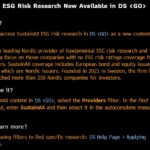ESG risk is like any other risk and cannot be understood only with an ESG risk rating
Co-authored by Alexander Miller, CIO at Odin Forvaltning and Dag A.D. Messelt, Senior ESG risk analyst and co-founder at sustainAX.
Today, there is far too much focus on the ESG risk ratings themselves among investors, but also in academia. It prevents understanding of the underlying risk elements and therefore prevents proper ESG risk integration in investment decisions. ESG risk, or sustainability risk, is risk within the environment, social conditions, and corporate governance, and also includes opportunities in the following.
ESG risk is risk like any other risk, and it is only natural to work with this in an integrated way, as investors already work with risk in investment decisions. There is really nothing new here in principle.
ESG confusion
When talking about “ESG” there is a lot of confusion in the market. One uses the term about exclusions, ESG-related thematic investments, sustainable investments and ESG risk integration, as well as most different combinations of these. After all, these have completely different intentions, respectively ethical choices, impact choices and the integration of the entire risk and opportunity picture in an investment decision. Here it is important to be clear about what you mean.
Capital owners versus capital managers
The different roles of capital owners and capital managers are also often mixed up. Capital owners can choose to make some choices, such as exclusion and sustainable investments, i.e. what they want to invest in and what they don’t, and one point in particular is mandatory for asset managers, namely ESG risk integration in the management processes. We will focus on the latter here, as the focus often seems to be in the wrong area.
ESG risk integration in investment decisions
ESG risk ratings are limited to indicating the total estimated ESG risk level and do not in any way tell which ESG risks a company has. One must therefore read the underlying ESG analysis to understand which ESG risks are relevant. The ESG risk rating is like a fever indicator, in order to understand what the underlying problem is, the doctor must investigate further. In the same way that an asset manager must further analyse whether the ESG, E, S or G risk rating indicates an ESG risk that does not correspond to his opinion.
As a manager, you have to look in many places for the source of financial risk and financial opportunities. One is used to looking among traditional commercial factors, for example. ESG risk is risk that can have financial consequences, for example the use of political instruments and regulatory changes to force a sustainable transition, changed customer behaviour and changed consumer preferences.
What is new or unusual is working on translating the ESG risks, highlighted by the ESG analyst and which you as a portfolio manager agree with, into financial figures for an investment object. It can be challenging and requires knowledge and training. What could it mean financially for income and costs, what is the probability of it happening and what time horizon is relevant?
It is unusual to use a score or rating when talking about traditional financial risk as an equity fund manager. At best, this should provide a sort of snapshot of where the company is right now. What you are trying to do is form a picture of critical factors that will affect the company’s financial development going forward, and here an understanding of ESG risks is important as many of them concern long-term strategic risks.
The way to go is to understand ESG risks and integrate these into investment decisions. This is required by fiduciary duty, and by EU regulations that FSAs now will monitor. ESG risk integration can actually be done without ESG risk ratings, but not without an ESG risk analysis which is based on knowledge of materiality for ESG risk and company-specific information.
About the authors:
Alexander Miller
Alexander was employed as investment director at ODIN in 2021. He came from the position of investment director at Eika Kapitalforvaltning. He has worked with asset management and finance since the end of the 90s and has solid experience from the industry.
Dag A.D. Messselt
Dag co-founded sustainAX, the leading Nordic fundamental ESG analysis and ESG rating provider in 2021. He has 30 years of experience from international capital markets and asset management and specialized over 5 years ago in ESG risk for investors.
About Odin forvaltning:
ODIN is one of Norway’s leading fund managers with a history dating back to 1990. The company is a wholly owned subsidiary of SpareBank 1 Gruppen AS with offices in Oslo, Stavanger, Stockholm, Gothenburg and Helsinki. ODIN aims to create future value to our customers by investing in companies with capable management teams, operating excellence and strong competitive positions, when the price offered by the market is attractive.
About sustainAX:
SustainAX is a leading Nordic provider of fundamental ESG risk research and ESG ratings, with a focus on those companies with no ESG risk ratings coverage from other providers. SustainAX coverage includes European bond and equity issuers, a majority of which are Nordic issuers. Founded in 2021 in Sweden, the firm has so far researched more than 250 Nordic companies for investors. As a specialist in ESG risk, SustainAX also provides training in ESG risk integration to asset managers and banks’ credit departments. More about SustainAX here:





